traction control ACURA NSX 1997 Service Repair Manual
[x] Cancel search | Manufacturer: ACURA, Model Year: 1997, Model line: NSX, Model: ACURA NSX 1997Pages: 1503, PDF Size: 57.08 MB
Page 592 of 1503
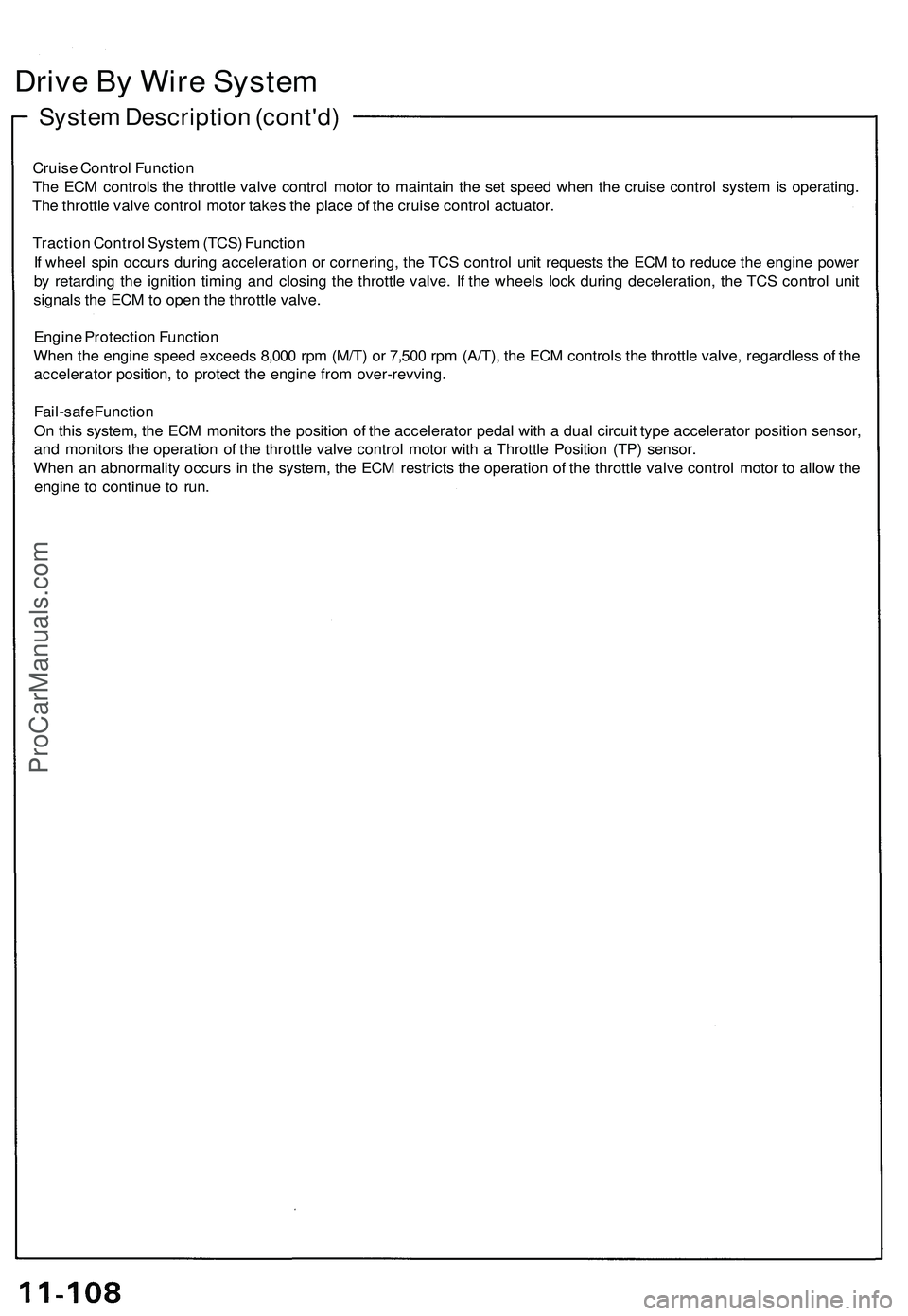
Drive By Wire System
System Description (cont'd)
Cruise Control Function
The ECM controls the throttle valve control motor to maintain the set speed when the cruise control system is operating.
The throttle valve control motor takes the place of the cruise control actuator.
Traction Control System (TCS) Function
If wheel spin occurs during acceleration or cornering, the TCS control unit requests the ECM to reduce the engine power
by retarding the ignition timing and closing the throttle valve. If the wheels lock during deceleration, the TCS control unit
signals the ECM to open the throttle valve.
Engine Protection Function
When the engine speed exceeds 8,000 rpm (M/T) or 7,500 rpm (A/T), the ECM controls the throttle valve, regardless of the
accelerator position, to protect the engine from over-revving.
Fail-safe Function
On this system, the ECM monitors the position of the accelerator pedal with a dual circuit type accelerator position sensor,
and monitors the operation of the throttle valve control motor with a Throttle Position (TP) sensor.
When an abnormality occurs in the system, the ECM restricts the operation of the throttle valve control motor to allow the
engine to continue to run.ProCarManuals.com
Page 1025 of 1503
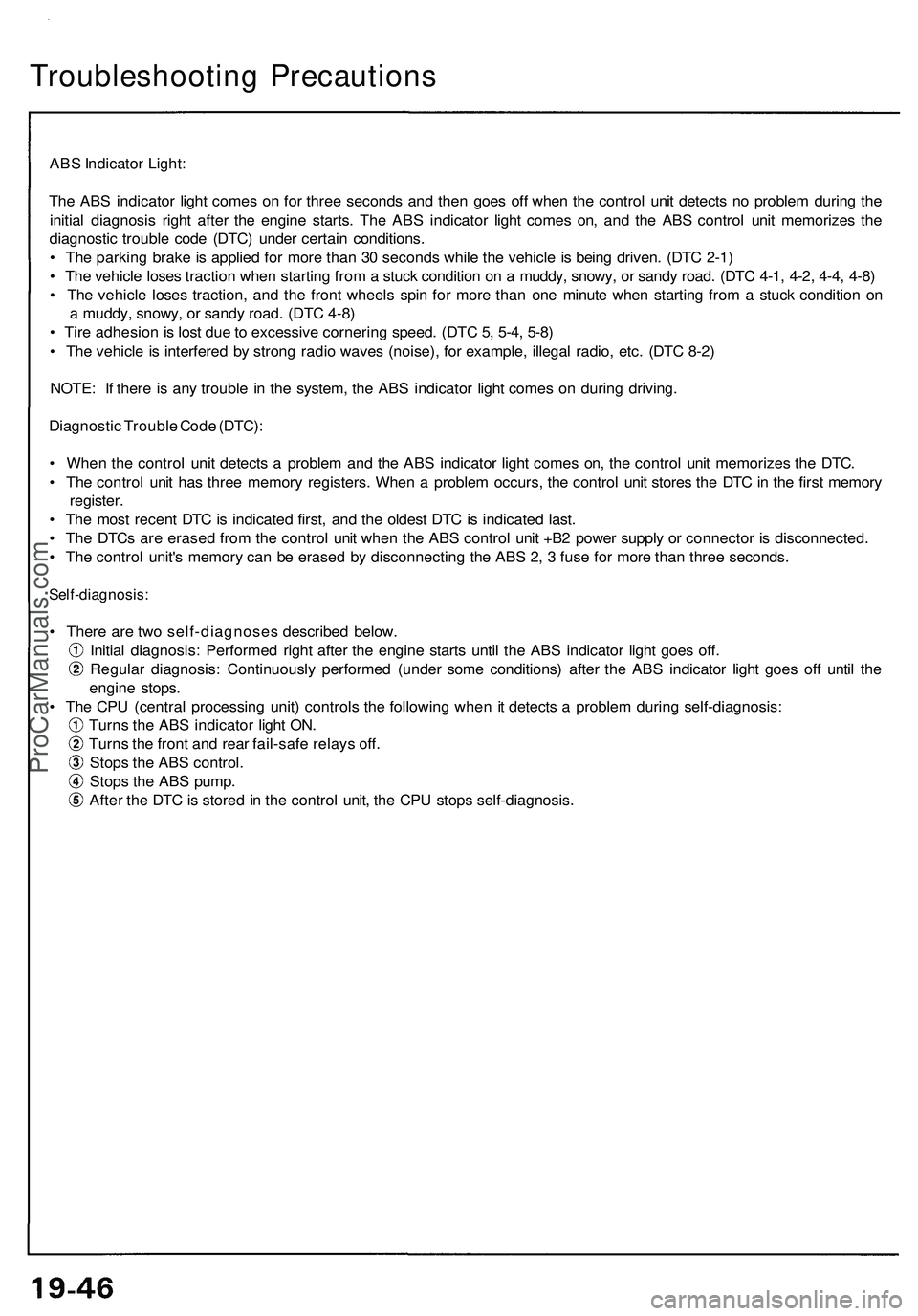
Troubleshooting Precautions
ABS Indicator Light:
The ABS indicator light comes on for three seconds and then goes off when the control unit detects no problem during the
initial diagnosis right after the engine starts. The ABS indicator light comes on, and the ABS control unit memorizes the
diagnostic trouble code (DTC) under certain conditions.
• The parking brake is applied for more than 30 seconds while the vehicle is being driven. (DTC 2-1)
• The vehicle loses traction when starting from a stuck condition on a muddy, snowy, or sandy road. (DTC 4-1, 4-2, 4-4, 4-8)
• The vehicle loses traction, and the front wheels spin for more than one minute when starting from a stuck condition on
a muddy, snowy, or sandy road. (DTC 4-8)
• Tire adhesion is lost due to excessive cornering speed. (DTC 5, 5-4, 5-8)
• The vehicle is interfered by strong radio waves (noise), for example, illegal radio, etc. (DTC 8-2)
NOTE: If there is any trouble in the system, the ABS indicator light comes on during driving.
Diagnostic Trouble Code (DTC):
• When the control unit detects a problem and the ABS indicator light comes on, the control unit memorizes the DTC.
• The control unit has three memory registers. When a problem occurs, the control unit stores the DTC in the first memory
register.
• The most recent DTC is indicated first, and the oldest DTC is indicated last.
• The DTCs are erased from the control unit when the ABS control unit +B2 power supply or connector is disconnected.
• The control unit's memory can be erased by disconnecting the ABS 2, 3 fuse for more than three seconds.
Self-diagnosis:
• There are two self-diagnoses described below.
Initial diagnosis: Performed right after the engine starts until the ABS indicator light goes off.
Regular diagnosis: Continuously performed (under some conditions) after the ABS indicator light goes off until the
engine stops.
• The CPU (central processing unit) controls the following when it detects a problem during self-diagnosis:
Turns the ABS indicator light ON.
Turns the front and rear fail-safe relays off.
Stops the ABS control.
Stops the ABS pump.
After the DTC is stored in the control unit, the CPU stops self-diagnosis.ProCarManuals.com
Page 1045 of 1503
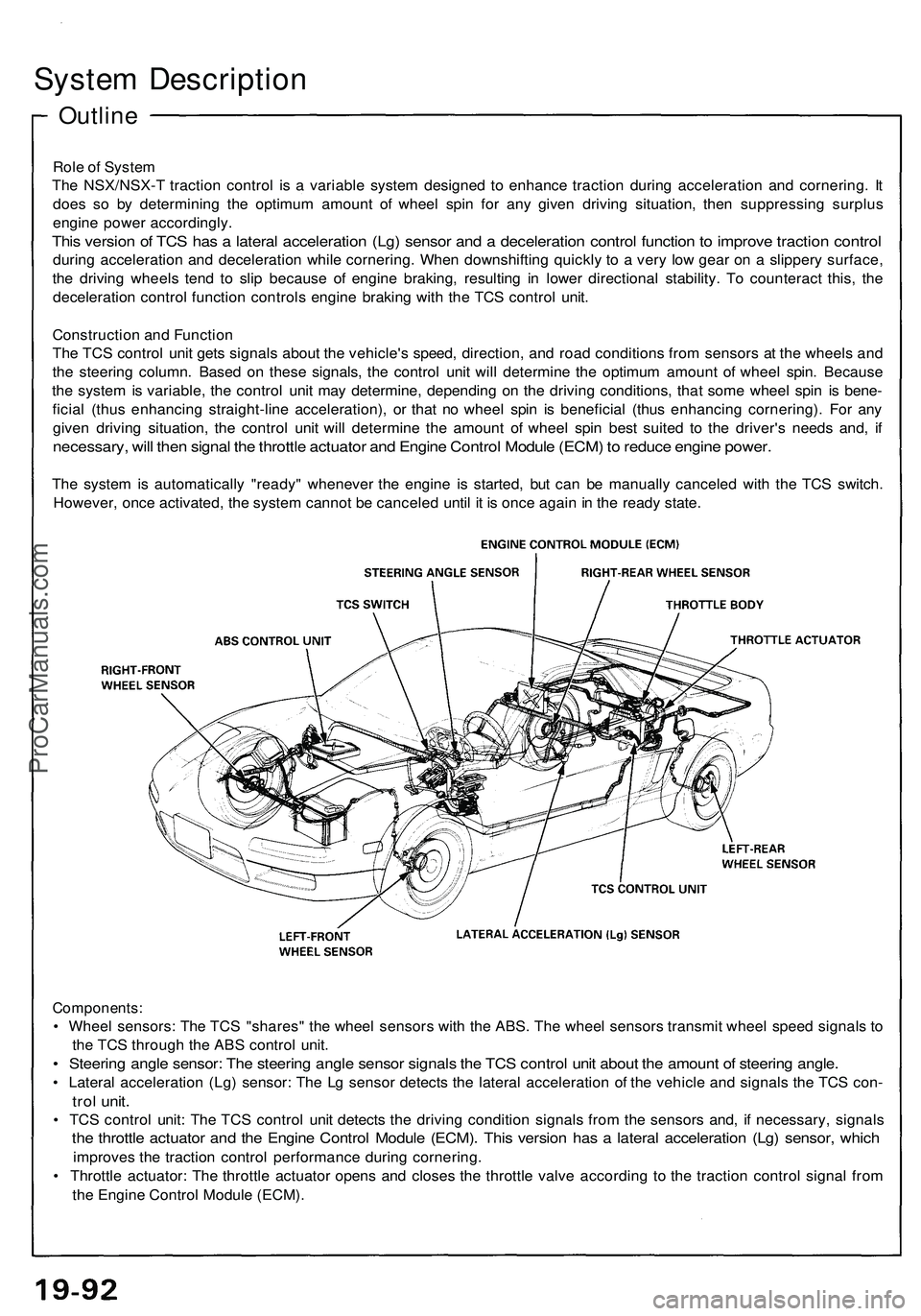
Outline
System Description
Role of System
The NSX/NSX-T traction control is a variable system designed to enhance traction during acceleration and cornering. It
does so by determining the optimum amount of wheel spin for any given driving situation, then suppressing surplus
engine power accordingly.
This version of TCS has a lateral acceleration (Lg) sensor and a deceleration control function to improve traction control
during acceleration and deceleration while cornering. When downshifting quickly to a very low gear on a slippery surface,
the driving wheels tend to slip because of engine braking, resulting in lower directional stability. To counteract this, the
deceleration control function controls engine braking with the TCS control unit.
Construction and Function
The TCS control unit gets signals about the vehicle's speed, direction, and road conditions from sensors at the wheels and
the steering column. Based on these signals, the control unit will determine the optimum amount of wheel spin. Because
the system is variable, the control unit may determine, depending on the driving conditions, that some wheel spin is bene-
ficial (thus enhancing straight-line acceleration), or that no wheel spin is beneficial (thus enhancing cornering). For any
given driving situation, the control unit will determine the amount of wheel spin best suited to the driver's needs and, if
necessary, will then signal the throttle actuator and Engine Control Module (ECM) to reduce engine power.
The system is automatically "ready" whenever the engine is started, but can be manually canceled with the TCS switch.
However, once activated, the system cannot be canceled until it is once again in the ready state.
Components:
• Wheel sensors: The TCS "shares" the wheel sensors with the ABS. The wheel sensors transmit wheel speed signals to
the TCS through the ABS control unit.
• Steering angle sensor: The steering angle sensor signals the TCS control unit about the amount of steering angle.
• Lateral acceleration (Lg) sensor: The Lg sensor detects the lateral acceleration of the vehicle and signals the TCS con-
trol unit.
• TCS control unit: The TCS control unit detects the driving condition signals from the sensors and, if necessary, signals
the throttle actuator and the Engine Control Module (ECM). This version has a lateral acceleration (Lg) sensor, which
improves the traction control performance during cornering.
• Throttle actuator: The throttle actuator opens and closes the throttle valve according to the traction control signal from
the Engine Control Module (ECM).ProCarManuals.com
Page 1046 of 1503
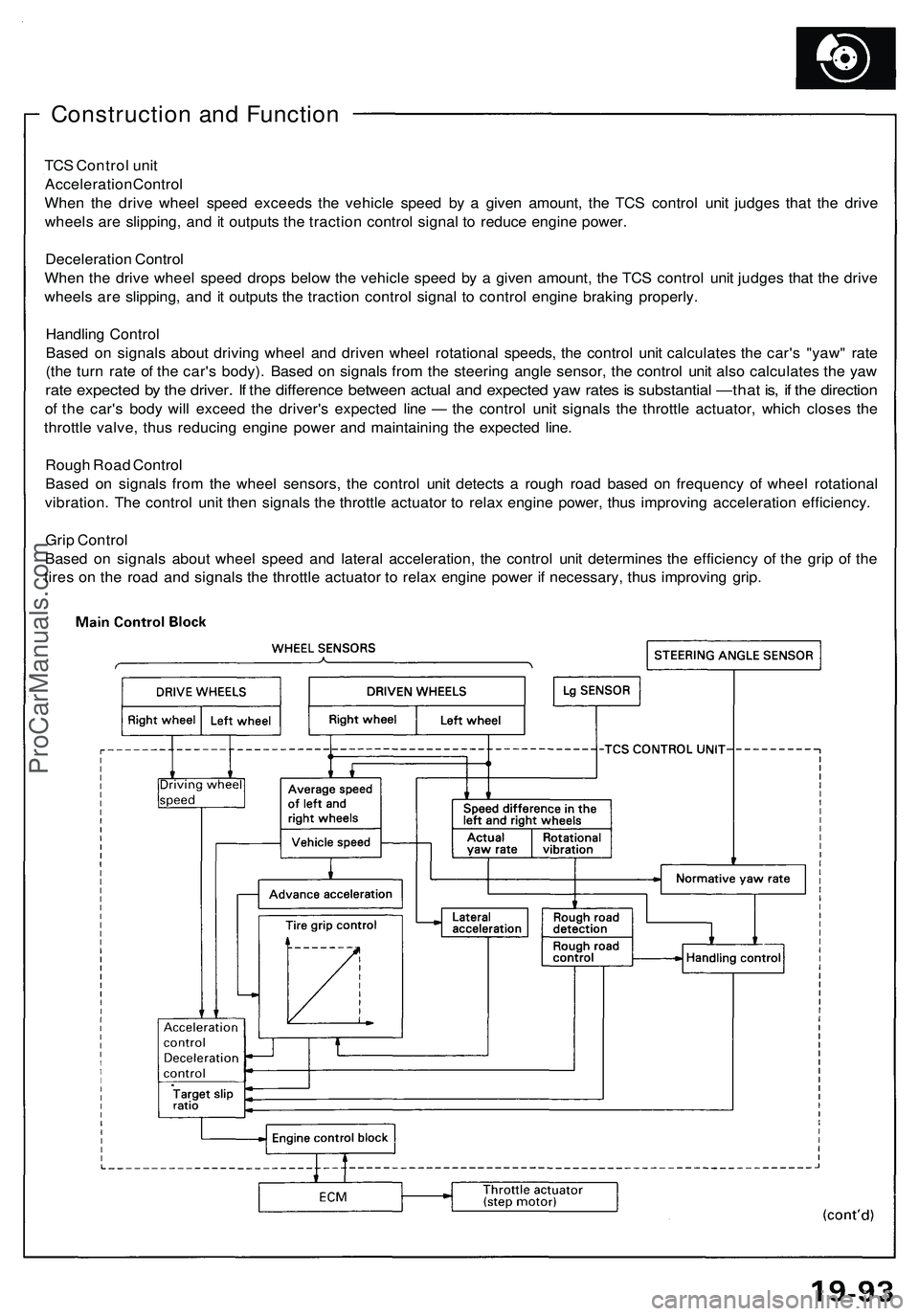
Construction and Function
TCS Control unit
Acceleration Control
When the drive wheel speed exceeds the vehicle speed by a given amount, the TCS control unit judges that the drive
wheels are slipping, and it outputs the traction control signal to reduce engine power.
Deceleration Control
When the drive wheel speed drops below the vehicle speed by a given amount, the TCS control unit judges that the drive
wheels are slipping, and it outputs the traction control signal to control engine braking properly.
Handling Control
Based on signals about driving wheel and driven wheel rotational speeds, the control unit calculates the car's "yaw" rate
(the turn rate of the car's body). Based on signals from the steering angle sensor, the control unit also calculates the yaw
rate expected by the driver. If the difference between actual and expected yaw rates is substantial —that is, if the direction
of the car's body will exceed the driver's expected line — the control unit signals the throttle actuator, which closes the
throttle valve, thus reducing engine power and maintaining the expected line.
Rough Road Control
Based on signals from the wheel sensors, the control unit detects a rough road based on frequency of wheel rotational
vibration. The control unit then signals the throttle actuator to relax engine power, thus improving acceleration efficiency.
Grip Control
Based on signals about wheel speed and lateral acceleration, the control unit determines the efficiency of the grip of the
tires on the road and signals the throttle actuator to relax engine power if necessary, thus improving grip.ProCarManuals.com
Page 1047 of 1503
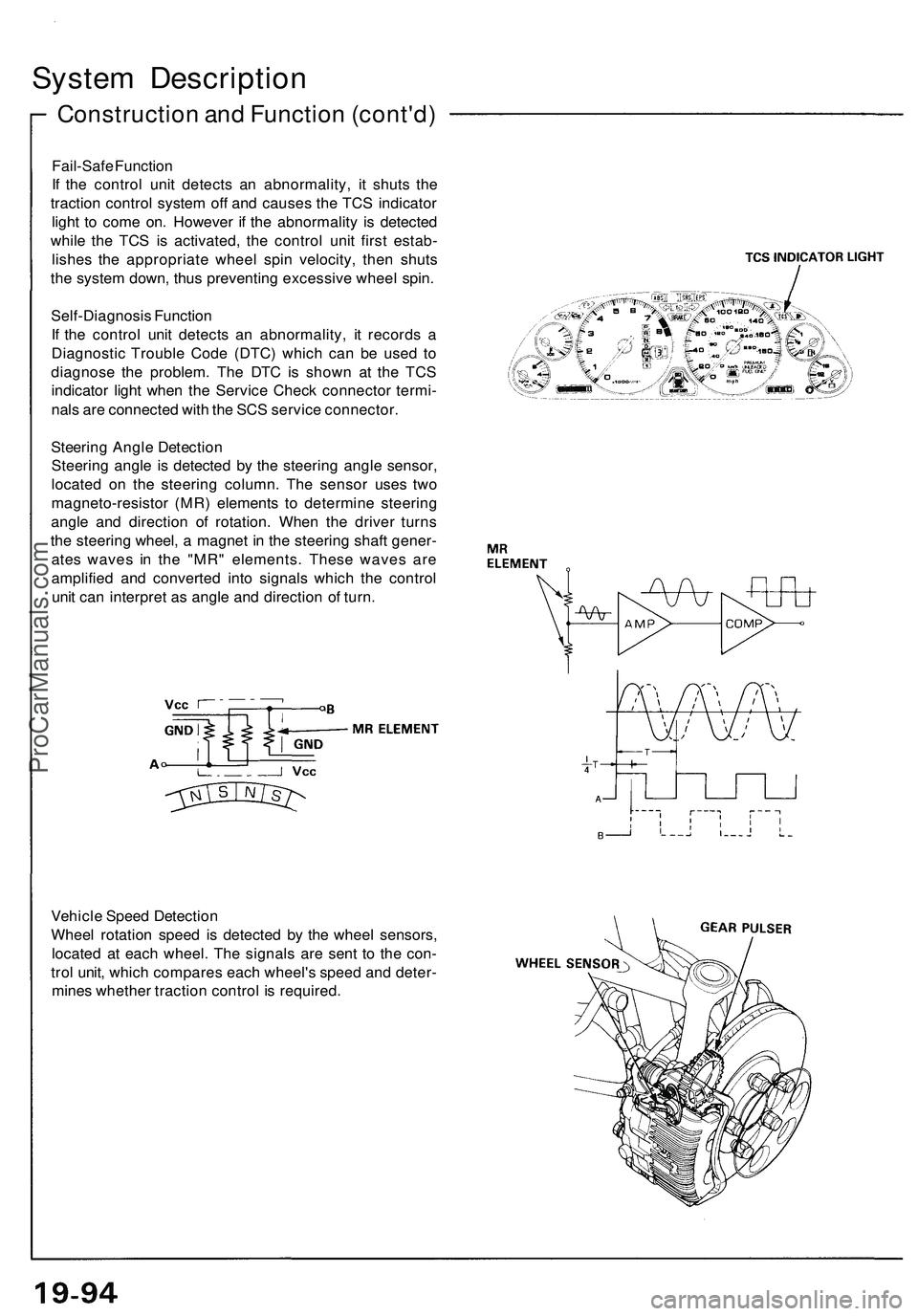
Construction and Function (cont'd)
System Description
Fail-Safe Function
If the control unit detects an abnormality, it shuts the
traction control system off and causes the TCS indicator
light to come on. However if the abnormality is detected
while the TCS is activated, the control unit first estab-
lishes the appropriate wheel spin velocity, then shuts
the system down, thus preventing excessive wheel spin.
Self-Diagnosis Function
If the control unit detects an abnormality, it records a
Diagnostic Trouble Code (DTC) which can be used to
diagnose the problem. The DTC is shown at the TCS
indicator light when the Service Check connector termi-
nals are connected with the SCS service connector.
Steering Angle Detection
Steering angle is detected by the steering angle sensor,
located on the steering column. The sensor uses two
magneto-resistor (MR) elements to determine steering
angle and direction of rotation. When the driver turns
the steering wheel, a magnet in the steering shaft gener-
ates waves in the "MR" elements. These waves are
amplified and converted into signals which the control
unit can interpret as angle and direction of turn.
Vehicle Speed Detection
Wheel rotation speed is detected by the wheel sensors,
located at each wheel. The signals are sent to the con-
trol unit, which compares each wheel's speed and deter-
mines whether traction control is required.ProCarManuals.com